Thunderbolt on Windows Part 2: Intel's DZ77RE-K75 & ASUS' P8Z77-V Premium
by Anand Lal Shimpi on June 3, 2012 2:08 AM EST- Posted in
- Motherboards
- CPUs
- Intel
- Asus
- Thunderbolt
- Ivy Bridge
- Chipsets
Hot Plug & Promise Pegasus, Now Supported Under Windows
For the past year, hot plug of Thunderbolt devices hasn't been supported under Windows—even on a Mac running Boot Camp. Any Thunderbolt device had to be present at POST for it to appear under Windows. In order to have a certified motherboard, BIOS/UEFI workarounds have to be present to allow for Thunderbolt hot plugging under Windows.
With a certified motherboard and a Windows certified Thunderbolt device, hot plug does work as you'd expect it to.

Promise provided us with a beta driver and firmware update that allowed us to use the Pegasus R6 under Windows. Hot plugging worked just fine.
The Promise Pegasus utility under Windows is actually a web based interface, but it provides the same basic functionality as the equivalent OS X application.
What happens if you don't have a certified driver? One of three things can happen. The device will either not work at all, it will compromise stability, or it will work but with some issues. The LaCie Little Big Disk is the perfect example of the last option. I just got a beta certified driver, but prior to receiving it this is what would happen when I plugged it into a running Windows system:
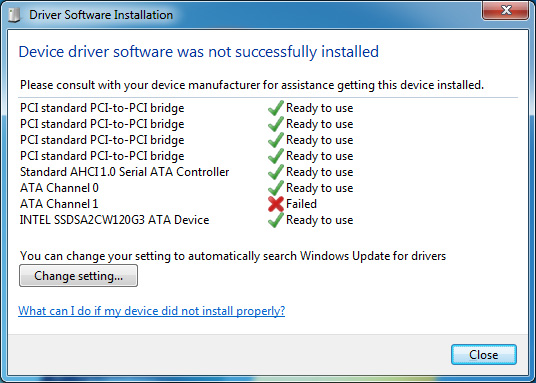
Only one of the two internal SATA channels was detected, meaning only one of the two internal drives was accessible. A reboot fixed this however.
The Elgato Thunderbolt SSD and Seagate's 2.5" GoFlex Thunderbolt adapter both use a different (lower power) SATA controller in order to stay below the 10W limit for a bus powered device (the cable, SATA and pre-Cactus Ridge Thunderbolt controllers combined already eat up around 5W).
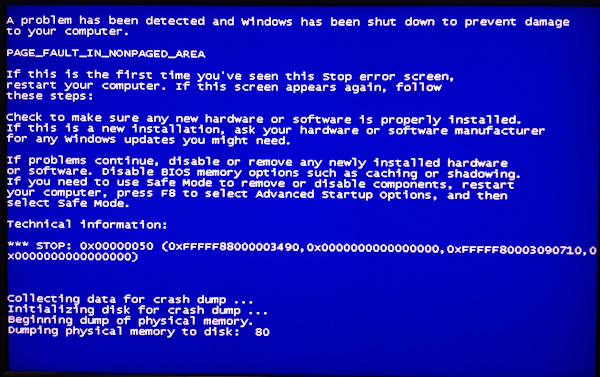
Unfortunately the ASMedia controller in these devices doesn't work well without a certified driver. Simply attaching the Elgato drive to a running Windows PC can cause a BSOD. Neither drive would even show up on either of the motherboards I tested; we'll simply have to wait for a certified driver here.
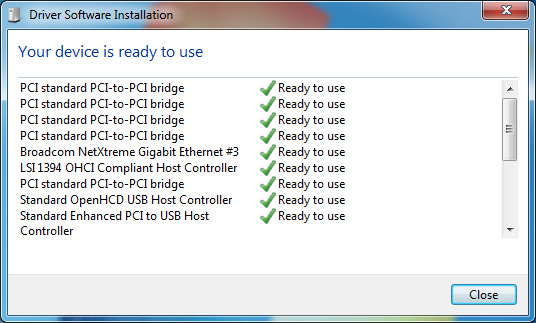
Apple's Thunderbolt Display works but not without a bunch of caveats. First you'll need access to a Mac to extract the drivers for the integrated components in the display (Firewire 800, GigE, etc.). Audio will work but only if you don't have a discrete GPU plugged into the motherboard. Firewire 800 and GigE both work. The integrated USB hub on the other hand basically doesn't work under Windows. Apple doesn't officially support the Thunderbolt Display under Windows and Intel won't certify it without Apple's support so anyone wanting to use a Thunderbolt display will just have to wait for someone else to release a similar product.
Remember the weird audio frame dropping issue I encountered under OS X with the Pegasus and Thunderbolt Display? I also encounter a similar but less severe version of that under Windows. While writing to the Pegasus and playing music through the Thunderbolt Display's speakers I get dropped audio frames, but unlike under OS X the music continues to play and is mostly recognizable—it just sounds like there's a little bit of static in the background. It's interesting that the problem exists under both OSes, but with slightly different behavior.


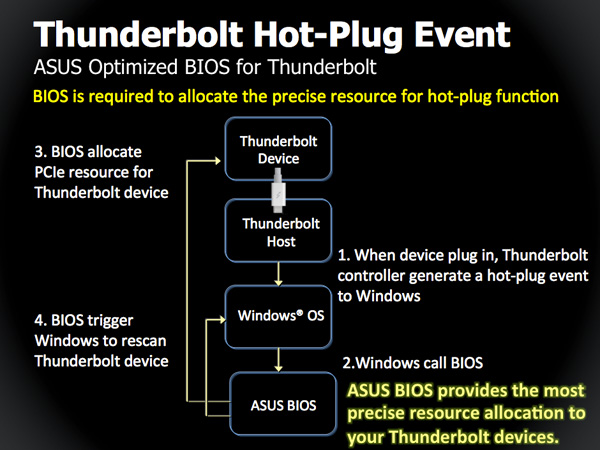
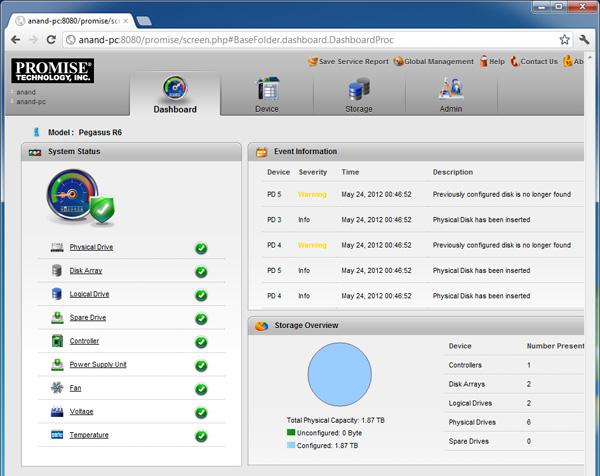














116 Comments
View All Comments
repoman27 - Sunday, June 3, 2012 - link
Stop for a moment and consider how many conductors would be required for a cable that simply combined USB 3.0, 1000BASE-T Ethernet and DisplayPort. Now think about the size of the connector it would require. Now ponder the insane amount of issues you would have wrapping all of those conductors in a single jacket, with pairs operating at wildly different signaling rates and voltages.The point of Thunderbolt is to equip a PC with one tiny connector that can provide an insane amount of bandwidth for connecting displays or external expansion devices. While passive cables that can handle Thunderbolt scale frequencies certainly exist, most of these cables don't include bus power and out-of-band signaling pairs. I think that if Apple could have gotten the job done without resorting to an active cable, they would have.
vol7ron - Sunday, June 3, 2012 - link
"Finally, all Thunderbolt traces are on the same PCB layer and don't feature any sharp angles in their route"For the one path that's right, but look at the other trace right next to it. It has a series of sharper turns than 45 degrees. Especially at the beginning and the ending of the path - at one point it makes a "U"!
JarredWalton - Sunday, June 3, 2012 - link
But it is a U and not a squared off |_| shape. I think that's an ASUS-specific implementation as well, but I could be wrong. As for why the U/zigzags are necessary (not that you asked), I guess both TB channels have to have the same trace length, which seems sort of odd to me. AFAIK, you can't actually talk to one device (e.g. a RAID controller in something like the Promise R6) on both channels; one channel is for DisplayPort passthrough, and the other is for the devices to share, right? I'm not sure...but I do think ThunderBolt is 10Gbps bidirectional, so that would make Anand's ~938MB/s results more sensible.repoman27 - Sunday, June 3, 2012 - link
I think you're only looking at a single channel in that pic, so the trace lengths probably need to be the same for both the send and receive pairs for each channel to maintain timings. The other channel is most likely on the other side of the board (despite the "no vias" bit) seeing as only 10 of 20 pads for the connector are visible on the side shown.According to Intel, each direction in each channel can be used for display and/or PCIe data. Each channel is 10 Gbps full-duplex, however, thus far we have only seen Thunderbolt controllers with a single PCIe to Thunderbolt protocol adapter, which limits total PCIe throughput to 10 Gbps.
The Thunderbolt switches built into the controllers, and the Thunderbolt channels that connect them, only transact in Thunderbolt packets—they don't concern themselves with which protocol the upper layers are using.
coder543 - Sunday, June 3, 2012 - link
Show me the Linux.Show me the Linux.
Show me the Linux.
Show me the Linux.
Show me the Linux.
Show me the Linux.
Show me the Linux.
Why is it so hard? I thought this was a technically proficient blog but time and time again I'm met with their absolute avoidance of Linux. I don't care one iota how Windows does on Thunderbolt. All I ask is a simple summary -- even a paragraph, about how Linux does on Thunderbolt, especially in regard to hot plugging. I hate to be annoying, but it bothers me tremendously.. Windows is inferior in every intrinsic technical capacity -- the only thing that makes it better for some people is the application compatibility.
coder543 - Sunday, June 3, 2012 - link
Also, it hasn't come to Windows PCs. It has come to non-Apple computers. I honestly wonder if Anand has ever used a serious Linux distro for more than ten minutes.. he talks as if there is only one player. Thunderbolt has serious implications in the server market, they just haven't been defined yet. Think about what can be done with it. There's no shortage of possibilities.coder543 - Sunday, June 3, 2012 - link
Looking historically, there hasn't been a Linux post here since January, and no Linux posts on this blog have ever been written by Anand. I smell MSCE. Time to branch out.CSMR - Sunday, June 3, 2012 - link
Thunderbolt is not for servers. The year of the linux desktop is next year, as usual. Thunderbolt seems to be mainly for laptops, and the year of the linux laptop has not even been announced.coder543 - Sunday, June 3, 2012 - link
I dislike responding to trolls, but I had little better to do at the moment, so for anyone who looks back they will have little doubt as to what went down here.I never said anything about the year of the Linux desktop. Linux doesn't need to win the desktop, as the desktop is rapidly becoming historical for most of the population. Everyone already uses Linux on a daily basis -- namely the web, their not-iPhone smartphones, their Kindles and Nooks, their Smart TVs, blu-ray players... everything. Even though Android is the major Linux smartphone/tablet OS for now, Boot2Gecko promises another Linux smartphone OS, and WebOS going open source is also more Linux. When people lose their desktops (and laptops), what's left? Linux. We don't care if you put it on your desktops, we've already won the battles that matter. End users don't want desktops or laptops these days. They want Kindle Fires and iPads -- things that aren't Windows. Apple is good stuff. Microsoft Windows is not. (WP7 on the other hand is actually respectable)
Thunderbolt does have uses in a server environment, a high speed interface which provides direct access to the PCI subsystem with daisy chaining support. If you can't see the potential there, then I don't know what to tell you. There are few uses for it *right now*, but in the future there will be, though it may not be for a few years, and the entrepreneur which utilizes it to his advantage will be a marked success.
Linux doesn't need to win the desktop share as I said, but it's currently far better than Windows, and if it's installed by someone technical, then anyone can use it, most of them with less frustration. What do most users do that isn't inside of a browser, word processor, email client, or music manager? Linux has every major browser that isn't called IE, and even then it can have IE in an interesting way, and LibreOffice does everything the average user need from an Office suite -- or they could run MS Office through wine where it is as deeply integrated as a native application. Thunderbird and Evolution are both great email clients, but Geary/Postler is redefining the end user email client. Music managers are a dime a dozen, any flavor you like. Banshee, Rhythmbox, Amarok, Noise, the list goes on, and all of them work very well.
This is all with the consideration that the computer doesn't reboot once every five minutes, consumes less RAM, is easier on the processor, and doesn't need antivirus, while supporting more file formats out of the box. Also, you don't need to install a driver for everything (or anything I've ever encountered for that matter) you plug in, and especially not flash drives. (Windows says installing driver when you plug flash drives in..) Let's not even mention saving the cost of Windows license -- everyone likes saving money.
How is that not a victory? Getting a faster, more intelligent, and less vulnerable computer. Just because the majority are ignorant or obstinate means little about the value of the product. Just because the majority decide it's ok to do a heinous crimes against their own population doesn't make it right. Linux five years ago was a steamy pile of crap, but things aren't now how they were then. Yet it doesn't matter. Linux was used in a bait-and-switch victory, and Microsoft is afraid. Their fear is the reasoning behind everything in Windows 8, and they have sealed their fate.
Iketh - Monday, June 4, 2012 - link
My goodness, I have never seen such a huge post say absolutely nothing...